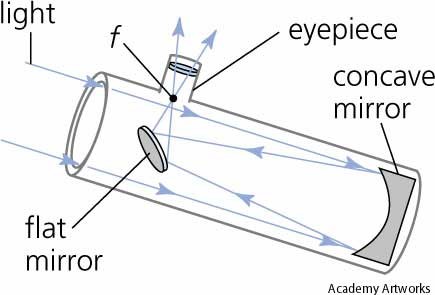
Imagine you have an image like this. This object is faint and faraway, so you can’t make out much more detail. You know that other stars like it—closer, brighter stars—have looked like this and turned out to be two stars, nestled very close together.
How do you figure out what you’re looking at? How do you increase the resolving power on your telescope so that you can make out more detail?
A telescope’s resolving power is limited by its size. Bigger telescopes can make out more detail on faraway objects—that’s because they can gather more light. But now, we can make telescopes that are so big their size doesn’t limit their resolving power anymore.
The atmosphere does.
We obviously can’t change the atmosphere. So how do we get around this particular predicament?
First of all, how come bigger telescopes can gather more light?

Same reason a larger bucket will collect more rain than a smaller bucket.
If you can collect more light, you can make out more detail. Have you ever shone a dim flashlight on a cave wall and tried to make out the details? What happened when you switched to a brighter beam?

The region to the right is clearly darker than the region to the left.
But do you notice that it’s also harder to make out details in the darker region? If something small—say, some sort of insect—fluttered over this cave wall, do you think you’d make it out better in the dark region or the brighter region?
Making out more detail is basically the definition of resolution, one of a telescope’s three powers.
So if you want better resolution, you want to gather more light from an object. And to do that, you need a larger telescope.
The problem, though, as I mentioned above, is that telescopes these days can be made so big, their resolution isn’t limited by their size anymore. Because every telescope has to look through the atmosphere, and that’s the true limit on resolution.
Well, not all telescopes. We’ve put some telescopes outside the atmosphere, in space…but that’s a story for another day.
The thing is, the atmosphere wiggles. It’s annoying to astronomers, but it’s true.
This is a problem because light has a bad habit of interacting with the atmosphere. And the atmosphere scatters the light. It basically makes each one of those little light waves bounce around like kids in a bouncy house.
And we all know how hard it is to gather up those rascally youngsters.
Light works in about the same way, and that means that there comes a point when you’d need an insanely huge telescope to get better resolution. And by insanely huge, I mean…maybe…oh, 200 meters in diameter?
Yeah, that just doesn’t exist in this world yet.
But…it does. In a way.

This is where interferometry comes in. All you need is a few large telescopes spaced a bit apart from one another, and some kind of computer system to combine all their images into one. And you get the resolution of a much larger telescope.
Interferometry doesn’t solve the problem of the atmosphere scattering the light. It does take us that much closer to better resolution.
Here’s how you do it:
First, you need to build a few very large telescopes. And I mean large. Not quite as large as the interferometer, but maybe…oh…around 8 or so meters in diameter, at the very least.
Technically, you could go for smaller, but what’s the point? 8 meters isn’t really that big as telescopes go, and bigger is always better.
Then you set them all up right near each other, like so.

The Very Large Telescope (or VLT) is an interferometer. These telescopes can all work individually, but see those light paths connecting them all? That’s the computer doing its work, transforming them into one big interferometer.
Obviously, to work as an interferometer, these telescopes all need to be looking at the exact same area of the sky. Otherwise, they’re not really helping each other resolve more detail on one object, are they?
The key to making interferometry work is to fool the light waves into thinking they were all collected by one big telescope. Which means that they all need to be carefully aimed parallel to one another.
Why? Because light waves go into a telescope parallel and come out parallel. The only reason they stop being parallel is because for a telescope to work, it has to reflect the light so it changes its angle and comes to a focus.
And…that’s a little beyond the scope of this post, but it basically means that a telescope’s job is to get parallel light rays to cross.

When these rays come out of a telescope, all the ones from the same telescope are parallel. But they might not be parallel to the ones from the other telescopes in the interferometer.
That’s the one weakness of an interferometer. Because we’re getting light from different telescopes that are experiencing different atmospheric turbulence, computer systems have to be very careful about straightening those light rays.
It all means that those light paths up above have to be constructed perfectly. There isn’t much room for error in their direction or in their inside surface. Visible light is easily scattered, after all.
But where interferometry is a delicate business for visual telescopes, it’s much easier for radio telescopes.
Wait a second…radio telescopes? I’ve heard of radio stations, but radio telescopes?
Yeah, they’re a thing, and I’ll talk a lot more about them coming up.

Here’s a radio interferometer. It works better than a visual interferometer, because it gathers radio waves rather than visible light waves—and radio waves are much harder to scatter. Why do you think they’re so easy to transmit via…erm…radio?
And yes, before you ask…radio waves are indeed related to visible light waves. They’re not sound waves. Both radio waves and visible light waves are part of the electromagnetic spectrum.
The electromagnetic spectrum is so important to astronomy that it’s going to come up in a lot of posts in the future.
I try to write these so that you don’t need to have read any previous posts to understand what I’m talking about, but it will help to have read my post on the electromagnetic spectrum.
Here’s the basics: the electromagnetic spectrum is a range of different wavelengths of radiation. Longer wavelengths have less energy, shorter wavelengths have more energy. Radio waves are towards the longer end. Visible light waves are right in the middle.

Radio waves are, in fact, the longest wavelength. The wavelength just longer than visible light is infrared, which you know as heat. Just shorter than visible light is ultraviolet, which causes sunburns—even though its heat doesn’t feel different from infrared to you.
And here’s another of radiation’s secrets. The longer the wavelength, the harder it is to scatter.
Which means that radio waves are perfect for interferometry. As the longest wavelength we know of, they’re the best at staying parallel even after penetrating the atmosphere and getting bounced around in the individual telescopes.
I know you’re probably dying to hear more about radio astronomy. Don’t worry—just two posts on cool astronomy tech to go, and we’ll get there!
Radio interferometers are astronomical instruments that detect radio waves to determine the distance and motion of objects in space.
LikeLike
thanks somewhat complex but interesting
LikeLike
I liked this, put simply and effectively ☺️
LikeLiked by 1 person
Good to hear 🙂 Imaging systems tomorrow!
LikeLike
How do you get time to write all of this?
LikeLiked by 1 person
At the expense of sleep, unfortunately. If I’m honest, I’m still learning balance. But I’m confident I can figure it all out. (Although, to be specific, it’s more at the expense of my circadian rhythm—I’d be going nocturnal if it weren’t for day classes.)
LikeLike